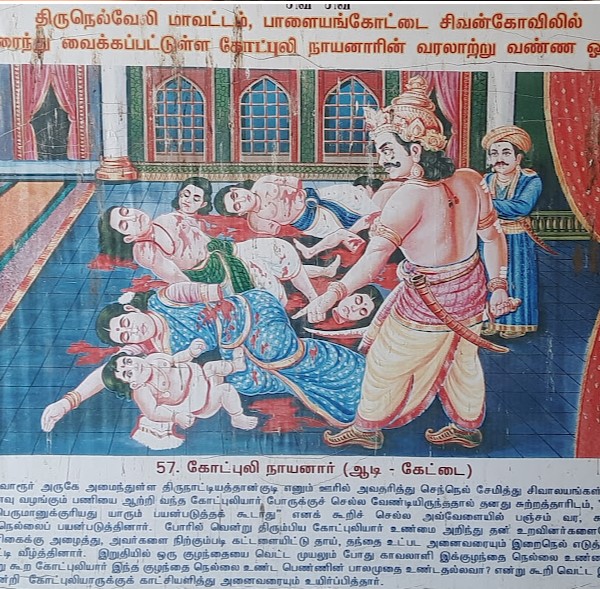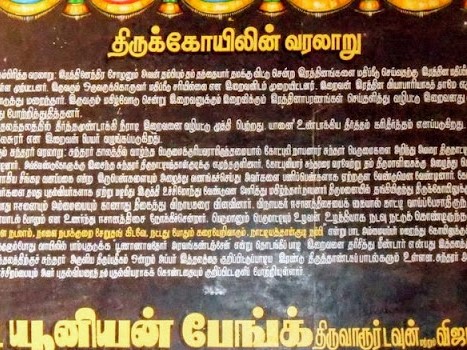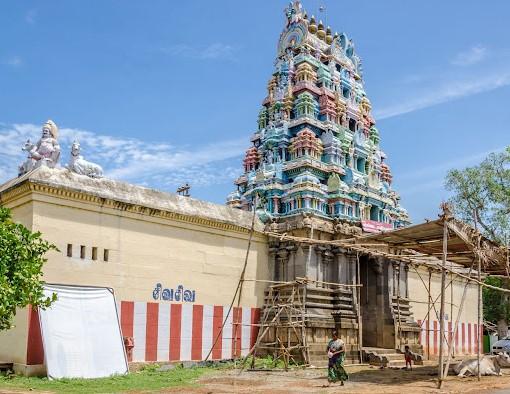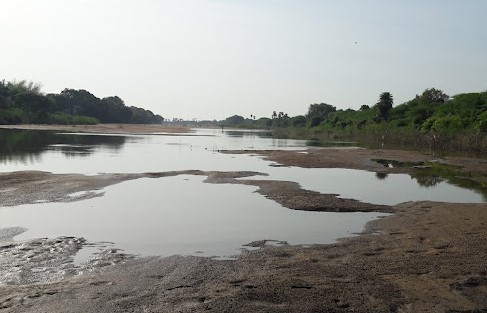
- Rathnapureeswarar Temple, located in Thirunattiyathangudi Village in the Thiruvarur District of Tamil Nadu, is a revered Hindu temple dedicated to Lord Shiva.
- This temple is recognized as the 235th Devaram Paadal Petra Shiva Sthalam and the 118th Sthalam on the southern bank of the River Kaveri in Chozha Nadu.
- The presiding deity, known as Rathnapureeswarar, is also referred to as Manikkavannar or Karinatheswarar, while his consort is Mangalambikai.
- The sacred tree of the temple is the Mavilangai, and the temple's holy water sources include Surya and Chandra Theerthams.
- Thirunattiyathangudi holds significance as the birthplace of Kotpuli Nayanar, one of the 63 revered Nayanmars.
- Additionally, the temple is mentioned in hymns sung by Sundarar in the Thevaram, highlighting its spiritual importance.
- The village is also referred to as Palakkurichi, preserving its name since the Thevaram period.
PURANIC SIGNIFICANCE:

Kotpuli Nayanar:
- Kotpuli Nayanar is associated with this temple and his association is commemorated each year in the month of Aadi. Kotpuli Nayanar, one among the celebrated 63 Nayanmars and a native of this place, was the commander of the Chola army. He was a furious tiger (Puli in Tamil) before the enemies, hence called Kotpuli. He used to spend a major part of his earnings in procuring paddy to be used for temple renovation purposes. Once, when he left for a war against the enemies, he left strict instructions to members of the family all stocks of paddy should be in fact saying that they belonged to Lord and warned that any personal or misuse by anybody would end in their death.
- Meantime, they can use it for temple use genuinely, he said. After his departure, famine engulfed the country. The family had but to use the paddy meant for temple use. Nayanar returned victoriously but was shocked that the paddy in the store had been used by his people. He asked his security to see that none escaped from the house. He called his parents, wife and children and mercilessly murdered them with his sword. One little boy was in a corner. The security asked Nayanar to spare him as he did not take food for days.
- Nayanar simply replied that though he did not eat the rice kept for the Lord, he would have been breast fed by his mother who misused God’s paddy and cut him into two pieces. Lord appeared before him with Mother Parvathi on his bull vehicle Nandhi and said that all his people had reached his Lotus feet and asked Nayanar to join them. He granted salvation to Kotpuli Nayanar.
Sundarar got darshan of Shiva & Parvathy as farmers:
- When Saint Sundarar came to the temple he was shocked that Lord and Mother were absent.
- Lord Kai Kattu Vinayakar showed the saint the northeastern direction where Lord and Mother were planting paddy siblings.
- Sundarar with the right of a devotee asked the Lord to stop the work for the day and requested to return and that he could do the pending planting next day.
- Responding to the appeal of the devotee they came into the temple.
Karinaleswarar:
An elephant created a spring here, bathed daily and was worshipping Lord Shiva and attained salvation. That spring is known as Kari (elephant) Theertham. The name Karinaleswarar stems from the worship offered by an elephant here.
Kotpuli Nayanar offered to Sundarar his daughters Singadi and Vanapagai:
Kotpuli Nayanar offered to Sundarar his daughters Singadi and Vanapagai as maids to serve him. Sundarar accepted them as his daughters. All the Moorthys in the temple are wearing a Rudraksha called Makarakandiga.
Rathnapureeswarar:
King Ratnendra Chola and his brother wanted to partition the diamonds left by their parents. They did not agree with the value determined by various assessors. Only confusion continued. Both sought the help of the Lord of the temple to decide the issue. Lord came in the guise of a diamond merchant and solved their problem and also in sharing the kingdom. As Lord came as diamond (Rathna in Sanskrit and Gem in English) merchant, He is praised as Rathnapureeswarar.
PURANIC SIGNIFICANCE 2:
Thirunattiyathangudi is notable as the birthplace of Kotpuli Nayanar. In this temple, Sundarar embraced Kotpuli Nayanar's daughters, Singadiyar and Vanappagaiyar, as his own.
Sundarar composed hymns reflecting his experiences in the temple, such as:
"கூடா மன்னரைக் கூட்டத்து வென்ற கொடிறன் கோட்புலி சென்னி..."
When Sundarar was at home, he went to worship Lord Shiva at the temple. Finding that Lord Shiva and Parvati were not present, he asked Vinayagar about their whereabouts. Vinayagar, remaining silent, pointed in the direction of the east. Following this indication, Sundarar discovered Lord Shiva and Parvati planting paddy saplings. He sang:
"நட்ட நடாக்குறை நாளைநடலாம்..."
After this encounter, Lord Shiva and Parvati returned to the temple, but Sundarar was momentarily obstructed by a snake at the temple entrance. Undeterred, he composed hymns like:
"Poonanavathor – பூணாணாவதோர்,"
and worshipped Lord Shiva, ultimately gaining entry to the sacred space.
ADMINISTRATION:
The Rathnapureeswarar Temple, located in Thirunattiyathangudi, Thiruvarur, is administered by the Hindu Religious and Charitable Endowments Department of the Government of Tamil Nadu. This temple is dedicated to Lord Shiva and is a significant site for devotees, known for its historical and architectural significance.


